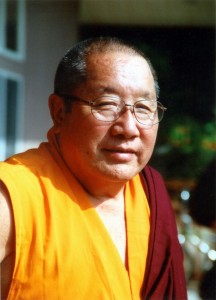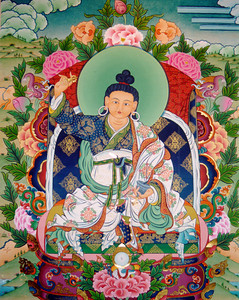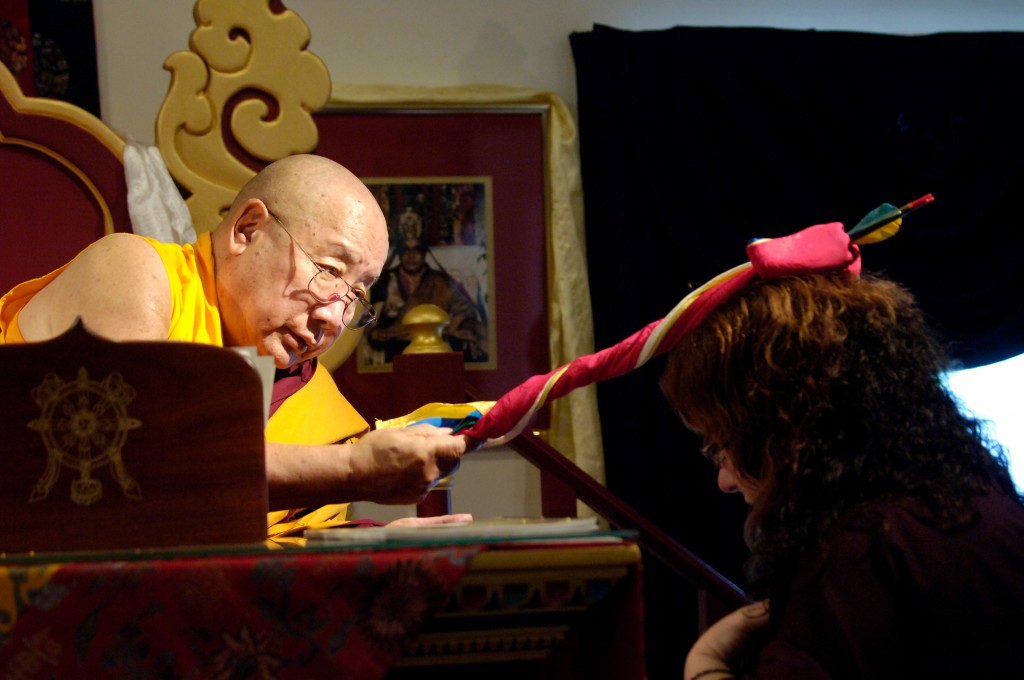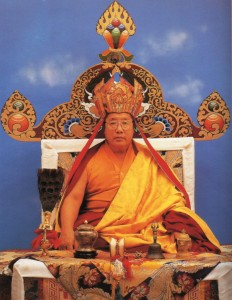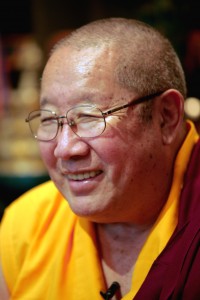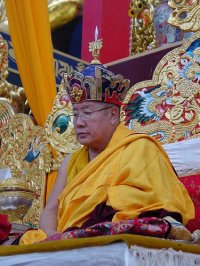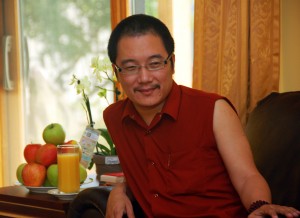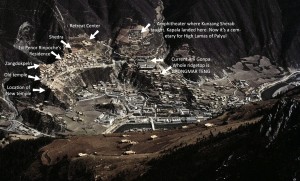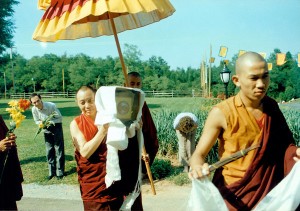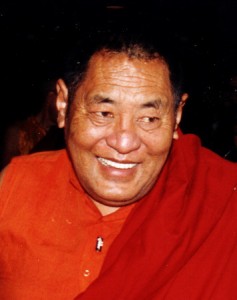
The following is an excerpt from a public talk given by His Holiness Jigme Phuntsok:
As we begin here this afternoon, I would like to mention a little bit about the great deeds of our sole guide and protector, Lord Buddha Shakyamuni, who before he became the Buddha initially gave rise to the awakened mind, the Bodhicitta, after which he worked for countless aeons to accumulate merit, finally culminating in his enlightenment under the Bodhi tree in Bodhgaya, India. Then 49 days later, for the benefit of all those gods and human beings and many others who would benefit indefinitely in future times as well, he turned the Wheel of the Dharma for the first time to bring the precious and holy Dharma into the world. Now, in fact, this is the auspicious day which commemorates the first turning of the Wheel of the Dharma, and because of that I feel that all of the outer, inner and secret omens have come together to make this a most auspicious occasion.
Also at this time, on this fully endowed occasion, in this world the greatest country that exists, the most sublime, the most exalted country in terms of fame and freedom and glory which is unequalled by any other, is the United States of America. Today for the first time I find myself in the capital city of this great land teaching the Dharma, and I am filled with joy. Furthermore there are three reasons why I am filled with joy. I feel that the leaders of this great land, who are actually the leaders of the world, are men and women who are concerned with bringing peace to this world and establishing the beings of this world in bliss and happiness. Towards this pursuit, they work effortlessly because they have the noble qualities and the abilities and the intelligence to actually make this come about. So I feel that they are here close to us, and this is the first reason why I feel a sense of joy: knowing that leaders such as this are in this vicinity.
The second reason I am filled with joy is because the general population of the human beings who live here in the United States of America are people who are endowed with a great amount of power and a great amount of material wealth. Just by the fact that they live in this country they also have freedom—freedom of choice and human rights. The condition is fully endowed. And when I think about all the people of this country having such auspicious and wondrous conditions, it is a great marvel to me, which makes me very glad.
Thirdly, the environment of this place, the particular endowment of the external environment, is that it is quite beautiful. There are beautiful rolling hills and forests, and although it is of cyclic existence, it seems to be somewhat like a celestial realm, a god’s realm, rather than an ordinary city. To see such a beautiful place as it is, I also feel great joy.
I had heard about this place before in Asia where I live, and it’s not until today that I actually come here. Now that I’ve really come and I am able to see for myself just how fully endowed it really is, that all the things that I heard are actually true and inconceivable, truly, then I feel even more joyful.
Now, we are Tibetan Buddhists, and in Tibet there are many traditions of Buddhism. Amongst them is the great Palyul tradition, the founder of which was the Vidyadhara Kunzang Sherab. Kunzang Sherab’s sister was the great dakini, Ahkön Lhamo, and she was very important in helping to establish and uphold the Palyul tradition at the time when it was first initiated in the land of Tibet. The great omniscient mind of primordial wisdom, His Holiness Penor Rinpoche, is the one who recognized her, who lives here in this land , in this incarnation, , I am especially happy to find her so well, in good health and so happy. To meet her here at this time gives me a great amount of joy.
As for all of the rest of you, the assembly of disciples, it is clear to me that you have very strong faith in the Buddhadharma, and this is also something that is very wonderful. You see, in Tibet there are many thousands of students who have been training in Dharma for many years, so it is not difficult for them to have faith and devotion, but here it is something quite extraordinary because this is not a Buddhist country. It is clear to me because of the kindness of Ahkön Lhamo who has brought many of you to the path of Dharma that this is why you have made this connection and this is why your faith is so strong at this time. I am very happy to see how this connection has been made and to see how the Dharma is flourishing here due to her kindness.
Especially too, here in the United States of America, with His Holiness the Dalai Lama as the leader, many other great lamas have come to this land, have stayed here for long periods of time and have given the Dharma teachings extensively. I visited some of those places at this time, however, the Dharma center of Ahkön Lhamo is different. I haven’t seen or felt any other place like it. That is because in Ahkön Lhamo’s center there are many ordained Sangha members. To see the robes of the ordained is something that brings me tremendous joy—to see how the Sangha, or the ordained community, has been established in the center. So, in particular, due to having seen the Sangha community flourishing in this way, I am extremely happy.
Generally speaking, in whatever country the Dharma may become established, it is very important for there to be a combination of the fully ordained, the partially ordained and the lay householders as a gathering of what we call the community of the Sangha. If you have just only the lay community and no fully or partially ordained community, it is incomplete, and vice versa. To have all of the different categories of holders of the Pratimoksha precepts together maintaining the Sangha community, it is considered to be fully endowed and complete, and that is what I see here in this center.
In particular, the category of ordination known as getsul, or novice, which of course includes the fully ordained, means those who have renounced the ordinary life of a lay person and who have taken on the life of an ordained practitioner. Now this status is something extremely important for the survival of Buddhism in any country at any time. This is something quite different from those who are called ngakpa, or mantra precept holders, who have no ordination according to the Pratimoksha per se. It is different because the doctrine can completely decline and vanish, and has over the course of time completely declined and vanished in places where there are only those holding the mantra precepts. In order for the survival of Buddhism to be assured anywhere in the world at any time so that it will always be flourishing, it is totally dependent upon the survival of the ordained Sangha.
Also as well in terms of the survival and the propagation of the Doctrine following this point of the survival of those who hold the Pratimoksha precepts, particularly that of full ordination, there is a prophecy from Lord Buddha which states that for 500 years occurring in ten successive stages of time, the Doctrine will increase and be propagated in the regions of the world. Now there are other prophecies that have to do with the land of Tibet and the Doctrine spreading to the north and surviving only in the north and then later going to the west and surviving in the western countries. According to this prophecy about the survival in the north, this refers to Tibet, which is the northern Snow Land of Tibet, the northern region of the world, and so there, of course, the lineage of ordination has propagated and survived. Then also according to the prophecy that it would spread into the west, that seems to indicate the western world, not necessarily western Asia. So when we look at the world in general and see now how in fact the lineages of ordination are moving into the western lands, then we can see how this prophecy is actually coming to pass. This is also something to rejoice about.
Henceforth, in general, because of Ahkön Lhamo’s efforts, the Doctrine is being established in this place, and also the lineage of ordination, which I will also pray, I do pray now and I will continue to pray to be ever increasing, to always be fully endowed, and that due to this there may always be peace and happiness for all the people of this place.
